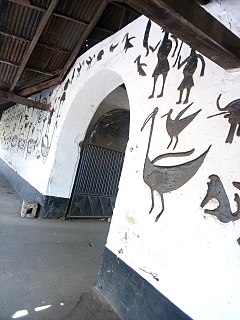Odarawu was an Alaafin of the Oyo Empire, who ruled briefly during the late seventeenth century. [1] He was reportedly the first Alaafin to be rejected by the Oyo Mesi (the seven main counselors of state). [1]

Alaafin, or Man of the Palace in the Yoruba language, was the title of the emperor of the medieval Oyo empire of West Africa. It was retained through the fall of that state as the official title of the ceremonial ruler of the contemporary natives of Oyo, Nigeria.

The Oyo Empire was a Yoruba empire of what is today Benin and North central Nigeria. Established in the 12th century, the Oyo Empire grew to become one of the largest West African states. It rose through the outstanding organizational and administrative skills of the Yoruba people, wealth gained from trade and its powerful cavalry. The Oyo Empire was the most politically important state in the region from the mid-15th to the late 18th century, holding sway not only over most of the other kingdoms in Yorubaland, but also over nearby African states, notably the Fon Kingdom of Dahomey in the modern Republic of Benin to the west.
Odarawu was the son of Ajagbo. He was on the throne for a short period of time. He was considered a man of bad temperament. According to Oyo legend his bad temper led him to being removed as king and also served as an educational warning and lesson to future kings on character development.
Ajagbo was an Alaafin of the West African Oyo Empire, whose long reign took place during the seventeenth century.

Legend is a genre of folklore that consists of a narrative featuring human actions perceived or believed both by teller and listeners to have taken place within human history. Narratives in this genre may demonstrate human values, and possess certain qualities that give the tale verisimilitude. Legend, for its active and passive participants, includes no happenings that are outside the realm of "possibility," but may include miracles. Legends may be transformed over time, in order to keep them fresh, vital, and realistic. Many legends operate within the realm of uncertainty, never being entirely believed by the participants, but also never being resolutely doubted.
Odarawu's major battle was also his first and last blunder on the throne. During his reign, he ordered the destruction of a town called Ojo-segi after one of its market traders (not realising to whom she was speaking) slapped him and accused him of being a thief. [2] Subsequently, the Oyo masses found him unfit to be king and he was asked to commit suicide.

A town is a human settlement. Towns are generally larger than villages but smaller than cities, though the criteria to distinguish them vary considerably between different parts of the world.i looked up riverside Wyoming and found it with towns in Germany england, and turkey. None are related to riverside Wyoming. What's up with that? I just wanted riverside Wyoming!
He was succeeded by Kanran.
